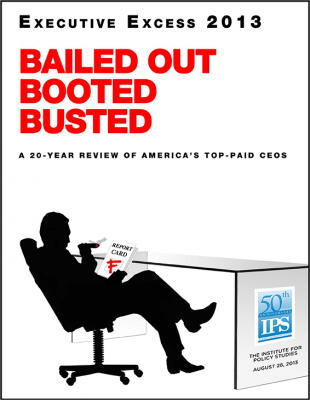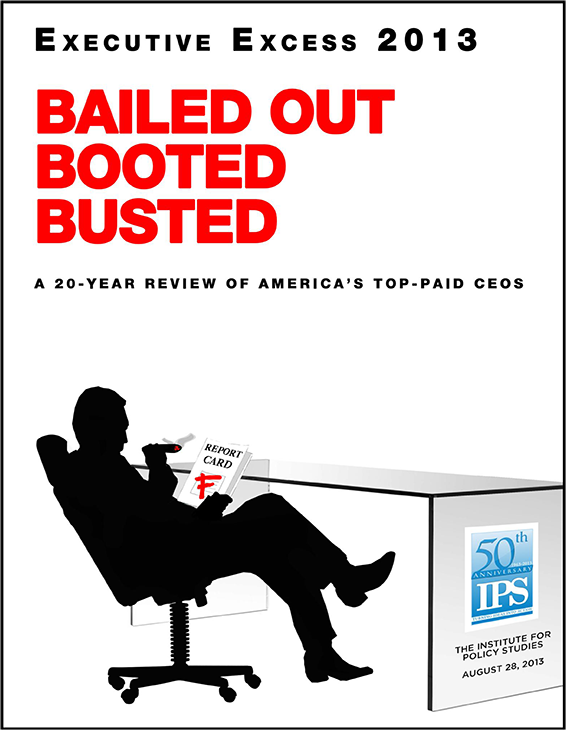Note: This op-ed was distributed via the McClatchy-Tribune News Service.
If anyone still believes this country has a “pay for performance” system for corporate executives, it’s time to put the notion to rest. For more than two decades, corporations have gotten away with this sham – at the expense of workers, shareholders and taxpayers.
The good news: there’s reason to hope that members of Congress could come together across the aisle to help end this charade by closing one loophole in the tax code.
 The “pay for performance” myth has been unraveling for years. Most of the myth-busting research has defined performance narrowly, as a matter of shareholder returns.
The “pay for performance” myth has been unraveling for years. Most of the myth-busting research has defined performance narrowly, as a matter of shareholder returns.
A new report I co-authored for the Institute for Policy Studies uses a more dramatic performance yardstick. We looked at CEOs who should be the creme de la creme – those who made the top 25 highest-paid lists in at least one of the past 20 years. We then identified how many of them had led firms that crashed or were bailed out in the 2008 crisis, how many had to pay massive fraud-related fines or settlements, and how many were fired.
The result? Nearly 40 percent of the top-paid CEOs fell into one or more of these “bailed out, booted, or busted” categories. A few noteworthy examples:
- Four CEOs of financial firms that received some of the largest bailouts in 2008 have reappeared on the top 25 highest-paid lists since the crash.
- Pfizer CEO Hank McKinnell got the boot in 2006 after the drugmaker’s stock plunged 40 percent. He still jumped out of the escape hatch with a golden parachute worth nearly $200 million.
- Dialysis giant Da-Vita HealthCare has had to fork over more than $350 million over the past year to settle various fraud cases. Nevertheless, CEO Kent Thiry made the top 25 highest-paid list in 2012 with more than $26 million in total compensation.
What can Congress do about any of this? They can begin by eliminating the loophole that allows corporations to deduct unlimited amounts off their income taxes for the expense of executive pay – as long as it is in the form of stock options and other “performance-based” pay.
At the time this provision was enacted in 1993, many believed that stock options would magically align the interests of executives and shareholders. In real corporate life, stock options encourage reckless behaviors designed to jack up share prices by whatever means necessary. During stock slumps, executives often receive boatloads of new options with lower exercise prices.
For example, after the crash had driven Goldman Sachs shares to record lows in December 2008, the bank’s top executives received nearly 36 million stock options – 10 times the previous year’s total. That positioned Goldman executives for massive new windfalls even if the bank’s share prices never regained 2007 levels.
Nevertheless, our tax rules still allow corporations to lower their tax bills by paying their CEOs more. And the rest of us wind up making up the difference. Congress’ Joint Committee on Taxation estimates that closing this loophole would generate $50 billion in revenue over 10 years.
Over the years, leaders on both the left and the right have criticized the “performance pay loophole.” At a 2006 Senate Finance Committee hearing, then acting Chairman Chuck E. Grassley, an Iowa Republican, declared the relevant section of the tax code (162m) “broken,” with “more holes than Swiss cheese.” Securities and Exchange Commission Chairman Christopher Cox, a George W. Bush appointee, said it should be placed in the Museum of Unintended Consequences.”
In 2009, Republican Sen. John McCain co-sponsored legislation that, among other goals, would’ve closed the “performance pay loophole.” Earlier this month, two Democratic senators – Jack Reed and Richard Blumenthal – revived the issue by introducing the Stop Subsidizing Multimillion Dollar Corporate Bonuses Act.
The debates that are expected to rage this fall over corporate tax reform are an opportunity to build bipartisan support for ending this outrageous loophole. For too long, taxpayers have borne the burden of the “pay for performance” scam.
